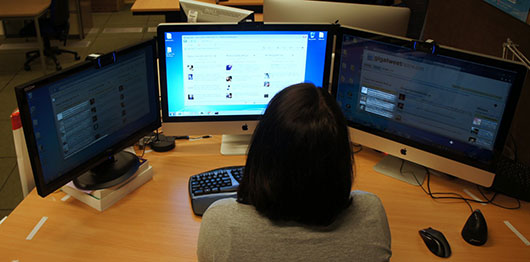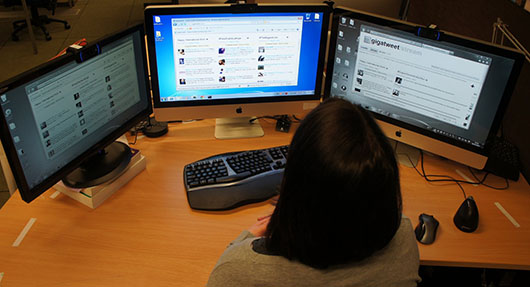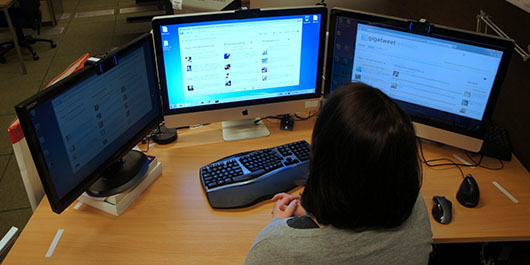Are you looking at me?

A person is looking at the centre display. The two displays to the left and right have been faded out by the system. Recurring changes in the unattended displays are visualised as bright pixels.
A new interactive multi-display system that can tell when you’re not paying attention has been developed by scientists at the University of St Andrews.
The researchers say that their new system could reduce workplace distractions, increase productivity and could even be of use in high pressured environments such as flight control rooms.
The revolutionary new system, called “Diff Displays”, aims to prevent computer users from missing anything new on their screen again.
The system detects when its user is not looking at a display and replaces the regular screen image with a calm and non-distractive visualisation of the screen’s activity instead.
The system reduces distractions by fading out the parts of the screen that remain static and by subtly visualising changes in the display over time. When the user looks back at a display, the system quickly changes back from the visualisation to the actual screen content via different forms of animation.
The system works via a camera mounted on top of each computer screen which uses computer vision algorithms to identify the user’s eyes. Once the eyes have been identified, the system can determine which screen they are looking at.
The researchers believe the system would be useful in everyday work situations to reduce distractions and improve the quality of life of office workers. However, it may also be particularly useful for those in high-pressure roles where they monitor a large number of screens, such as flight controllers or workers in nuclear power stations.
A study of the system in action during a single work week indicated it reduced the number of times someone switched their attention between the displays. The researchers think this technology can eventually become a standard part of our operating systems.
PhD student Jakub Dostal who works under the guidance of Dr Per Ola Kristensson and Professor Aaron Quigley in the School of Computer Science, said, “In a world where displays are starting to surround us and crave for our attention, technologies that focus on inattention become ever so important.
“Diff Displays is an example of intelligent display technologies that can be rapidly deployed and have a positive impact on potentially billions of users.”
This week the researchers will travel to Santa Monica in California to present the results of their research at the ACM International Conference on Intelligent User Interfaces (IUI 2013). IUI serves as the principal international forum for reporting outstanding research and development on intelligent user interfaces.
The system Diff Displays is available as a free download for Microsoft Windows. The program, illustrations and a video of the system are available.
Note to Editors
Dr Per Ola Kristensson is available for interview today on 01334 463690 or mobile 07955 895493
Images of the display at work are available from the Press Office – contact 01334 462530.

The display is dimmed when the user looks away from the screen. The display is “frozen” whenever the user looks away from the screen.

The display is dimmed when the user looks away from the screen. Windows communicate visual changes within them by emitting bright rectangle whenever a change occurs within the window.

The display is dimmed when the user looks away from the screen. Windows communicate visual changes within them by becoming increasingly brighter the more changes that occur within the window.
Issued by the Press Office, University of St Andrews
Ref: Are you looking at me 180313
View the University’s latest news
Category Research